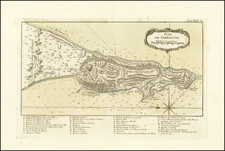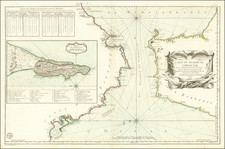The Beginning of the Great Siege of Gibraltar
Rare topographical map of Gibraltar and environs, published by Guillaume Dheulland in Paris.
The map illustrates the Siege of Gibraltar during the month of July, 1779. The map illustrates the positions of the Spanish ships firing on the English fortifications at Gibraltar in the first month of the siege, which would last until February 1783.
The Great Siege of Gibraltar was an unsuccessful attempt by Spain and France to capture Gibraltar from the British during the War of the American Revolution. The American war had ended with the British defeat at Yorktown in October 1781, but the Bourbon defeat in their great final assault on Gibraltar would not come until September 1782. The siege was suspended in February 1783 at the beginning of peace talks with the British.
On 16 June 1779 Spain entered the war on the side of France, attacking the British base at Gibraltar was Spain's primary war aim. The vulnerable Gibraltar garrison under George Augustus Eliott was blockaded from June 1779 to February 1783, initially by the Spanish alone, led by Martín Álvarez de Sotomayor. The blockade proved to be a failure because two relief convoys entered unmolested—the first under Admiral George Rodney in 1780 and the second under Admiral George Darby in 1781—despite the presence of the Spanish fleets. The same year, a major assault was planned by the Spanish, but the Gibraltar garrison sortied in November and destroyed much of the forward batteries.
The besiegers were reinforced by French forces under de Crillon, who took over command in early 1782. After a lull in the siege, during which the Franco-Spanish besiegers gathered more guns, ships and troops, a "Grand Assault" was launched on September 18, 1782. This involved huge numbers—60,000 men, 49 ships of the line and ten specially designed, newly invented floating batteries—against the 5,000 defenders. The assault proved to be a disastrous failure, resulting in heavy losses for the Bourbon attackers.
This was the largest action fought during the war in terms of numbers.










![[Great Siege of Gibraltar] Plan Géometral De La Montagne Et De La Ville De Gibraltar : avec une Carte particuliere du Detroit de même nom.](https://storage.googleapis.com/raremaps/img/small/81781.jpg)


![[ Gibraltar ] Plan Topo-Hydrographique de la Baye de Gibraltar](https://storage.googleapis.com/raremaps/img/small/74381.jpg)
